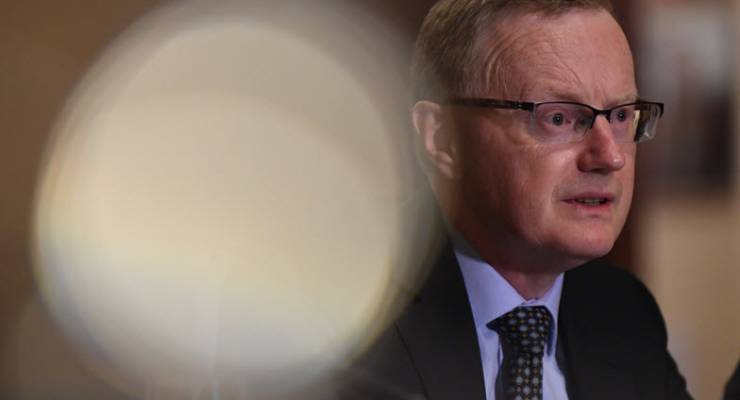
Another speech, another reference to the economy being at a “gentle turning point” according to Reserve Bank governor Philip Lowe, who used the phrase in the post-RBA board meeting statement yesterday, which described another cut in the cash rate to a record low of 0.75%.
In remarks he made last night at a business dinner in Melbourne, he found more to be optimistic about:
“The economy has been through a soft patch recently, but we are expecting a return to around trend growth over the next year. There are a number of factors that are supporting this outlook. These include the low level of interest rates, the recent tax cuts, ongoing spending on infrastructure, signs of stabilisation in some established housing markets, and a brighter outlook for the resources sector. Together, these factors provide a reasonable basis for expecting that the economy will remain on an improving trend from here.”
But will it? Lowe’s two public speeches yesterday tell a conflicting story — part optimism, part gloom, with the latter on show when talking about the central issues for the RBA at the moment: the health of the labour market, wages and incomes, and consumer spending.
The rate cut yesterday raises the very real question as to why, with two quick rate cuts under its belt this year, did the RBA give us a third on Tuesday? So for all the optimism of the governor in his statements, there was also a fair bit of gloom and frustration. Wages are not rising, consumers are not spending, unemployment is up and the federal government is hugging its “surplus” and won’t let go because it is bereft of any ideas to help the economy shake off the blues. The government also refuses to help the RBA except for the tenuous benefits of tax refunds that have had no impact at all so far.
The central problem for the economy is the lack of any momentum from consumers. The cumulative impact of weak incomes and wages, leading to weak spending, have whacked the economy since early 2018, and the prescription from the Morrison (and Turnbull governments) has been more austerity and more spending cuts (unless on silly things like defence, or deliberately holding-back spending on things like the NDIS).
The health of the labour market, wages and and weak inflation are also central issues for the bank. The bank knows unemployment and the jobless rate are going to edge up over the next year. The August quarter’s fall in job vacancies, especially in the dominant private sector, tells us unemployment is on the way up, especially with the number of unfilled positions now back to early 2018 levels. Private credit growth hit a more than eight-year low in the year to August. That’s the lowest since August 2011 and came with falls in lending across the board.
It is still too early to say when and where the rate cuts will have an impact, but the fact that a third was added on Tuesday tells us that the RBA is not very confident the first two will have much impact anytime soon, which makes Lowe’s confidence about a return to trend growth in the next year looks tenuous. There’s a chance inflation might make it back to the RBA’s target range of 2-3% over time (it was last there briefly in the June quarter of 2018 with an annual reading of 2.1%, which quickly fell away), but that will only happen if more jobs are created and wages start rising. That’s why the readings from the wage price index over the next two quarters will be vital.
For any hope of inflation to return to the target range, the index has to rise from the current annual rate of 2.3%, and private wages have to grow from the current 2.3% (public sector wages are rising at a rate of 2.5%, despite the caps imposed by various governments).
Judging by what Lowe said in his post-meeting statement and in his remarks on Tuesday night, that is going to be unlikely if “wages growth remains subdued”. And that remains the most likely scenario for the rest of 2019 and into 2020, despite the trio of rate cuts.








Crikey is committed to hosting lively discussions. Help us keep the conversation useful, interesting and welcoming. We aim to publish comments quickly in the interest of promoting robust conversation, but we’re a small team and we deploy filters to protect against legal risk. Occasionally your comment may be held up while we review, but we’re working as fast as we can to keep the conversation rolling.
The Crikey comment section is members-only content. Please subscribe to leave a comment.
The Crikey comment section is members-only content. Please login to leave a comment.